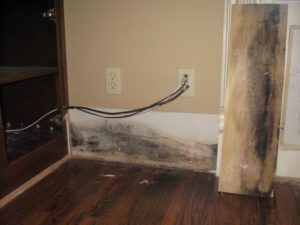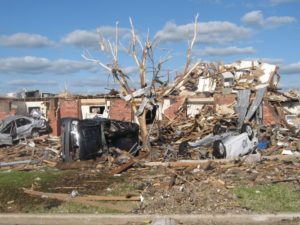Basics of Black Mold:
Mold is a family of fungus that exists as clusters of small spores that can travel through the air and thrive in humid, warm, and moist areas. Although many types of mold are harmless, Stachybotrys chartarum, also known as toxic black mold, is detrimental to human health if found inside buildings and residences. While the mold itself is not actually toxic, the spores emitted into the air are. Since mold spores are light and can travel through air, inhaling black mold can cause harmful health effects, which will be explained below in more detail. Black mold typically takes on a dark black color, compared to the more greenish or greyish coloring of other varieties of mold, and infestations can cause headaches for homeowners when it comes to mold removal. This article will help readers better understand the causes of black mold, methods for mold remediation, and the best ways to undertake mold removal.
Causes of Black Mold:
For black mold to grow and multiply in a building, several conditions need to be met. Firstly, Stachybotrys chartarum mold spores need to be present in the vicinity. There also needs to be enough warmth and moisture through humidity or water leaks, as well as a lack of ultraviolet rays, which kill spores. Some mold types only need 55% humidity or higher to start growing, and common culprits of increased risk for mold growth include using a humidifier and drying clothes indoors. Other causes of mold include leaky roofs, condensation, leak pipes, and poor ventilation.
Mold multiplies by feeding on organic matter that is present in buildings. This organic matter is found in common household building materials, such as carpet, insulation, drywall, and sub-flooring. Once these conditions are met and spores have enough oxygen, mold can begin growing in as fast as 24-48 hours. Black mold typically is accompanied by a musky, mildew smell, and is oftentimes found in basements and bathrooms. When the breeding conditions are met for mold growth, it may be important to begin considering avenues for mold removal.
Health Effects that Accompany Black Mold:
Unsure of whether or not your residence has a mold infestation and needs mold removal or not? Many health symptoms accompany a mold infestation. Long-term exposure to toxic mold can lead to irreversible damage to the body, so it is important to be aware of when there might be mold damage in a residence and to act quickly to start mold remediation. Below are some of the common symptoms. The extent to which these health symptoms are present depends on the amount of time that one has been exposed to black mold.
- Respiratory problems, including coughing, sneezing, and irritated mucous membranes
- Irritation to the eyes and skin inflammation
- Tiredness and headaches
- Nausea and vomiting
- Intensified allergic reactions
- Hemorrhage
- Mental impairment
- Immune system suppression
- Internal organ damage and eventually organ failure
Black mold produces mycotoxins, which acts as a neurotoxin and can cause long-term brain damage. Long-term health effects like immune system suppression and damaged organs are irreversible. Mold affects not only humans but pets as well. For pregnant women, black mold can cause miscarriages, birth defects, and infertility later in life. If anyone in the household is experiencing the aforementioned symptoms and there are areas in the building that fit the conditions for mold growth, it is important that you contact and employ professional mold remediation services right away to minimize negative health effects for you and your family.
How to Prevent Mold in Your Tulsa Homes and Buildings:
Mold remediation can be very costly, and mold spores oftentimes cannot be completely eradicated, so it is crucial to take steps to prevent mold from growing in the first place. Mold spores exist naturally in the environment at manageable levels that do not necessarily inflict negative health consequences, so the key to preventing extensive black mold growth is to control moisture levels.
To begin, increase the mold-resistance of your Tulsa residency by fixing any vulnerable structures. This includes conducting a thorough audit of the house to better understand its current state. Leaky pipes should be repaired immediately, and older roofs should be replaced. Basements can be particularly susceptible to mold growth, so ripping out old carpeting and checking for possible flooding is key. Secondly, wet areas in the house should be dried as soon as possible. This could include wiping up any spillages and drying any wet clothes, as mold can begin growing within days if moisture is present. Be aware that household plants can become breeding grounds for mold, so keep plants with damp dirt in areas with plenty of sunlight and good air flow. Thirdly, make sure that the residence is equipped with proper ventilation systems. Bathrooms and kitchens should have fans installed to remove any extra built-up moisture that accompanies showering and cooking. Fourthly, stores now sell mold-resistant building materials, so renovators should look for drywall and other home materials that fit the bill. Lastly, it is important to understand the climate in the area that you live in. Is it rainy during certain times of the year, which means you will need to be extra careful during those months? Being aware of how moisture can build up in your residence and keeping humidity levels low can save homeowners time and money by reducing their need to hire mold removal and mold remediation services.
Mold removal is crucial when there is already an outbreak of mold in the residence. However, it is important to remember that mold spores exist naturally, so mold removal can never completely remove all mold spores from the residence. Mold remediation can be very expensive, so taking steps to prevent mold from growing in the first place is very important. Most importantly, mold removal should always be done by professionals, as incorrectly dealing with black mold incorrectly, such as by wiping the mold, can cause spores to fly into the air and spread. When coming into contact with black mold, it is important to wear a respirator designed for working with mold and to cover all exposed skin.
To begin the mold removal process, hire a professional mold inspector in Tulsa, who can help document the mold problem in your home. The professional may take air samples to track the extent of the problem and suggest the best avenues for mold removal. The inspector should be a Certified Industrial Hygienist or Council-certified Indoor Environmental Consultant, and will usually cost $200-$600 per visit. The inspector should not be an employee of a mold remediation service to ensure impartiality.
Afterward, hire a mold remediation specialist. Mold remediation companies will work for anywhere between a few days and a few weeks to repair damage, depending on the extent of the damage. Mold remediation services can include cleaning, disinfecting, and vacuuming infested surfaces with high-efficiency particulate air filtration, as well as removing and rebuilding drywall if the damage is extensive. It is critical that professional help is hired, as even dead mold spores can still cause allergic reactions. Typically, mold remediation services will cost between $500-$6000 for minor to medium damage to ducts and crawl spaces to $10,000-$30,000 for major damage.
Don’t Let Mold Create Further Problems In Your Tulsa Home or Business
When the inevitable happens, and your Tulsa building or home requires mold remediation, contact the Reset Restoration mold remediation experts immediately. Reset Restoration provides 24/7/365 emergency mold remediation response. If you have joined our free PREP program, immediate priority response is included, along with many other special no-charge services.
If your friends, family and neighbors have had significant mold damage to Tulsa homes or businesses you can contact Reset Restoration mold remediation experts in Tulsa 24/7 to inquire about Tulsa mold remediation services. Call Reset Restoration today at (918) 582-7373.
Follow Reset Restoration on Facebook!




